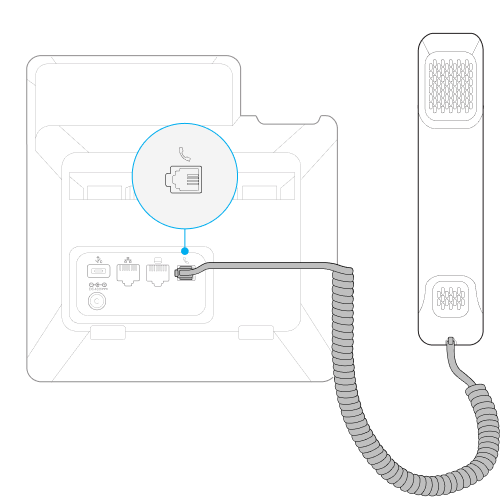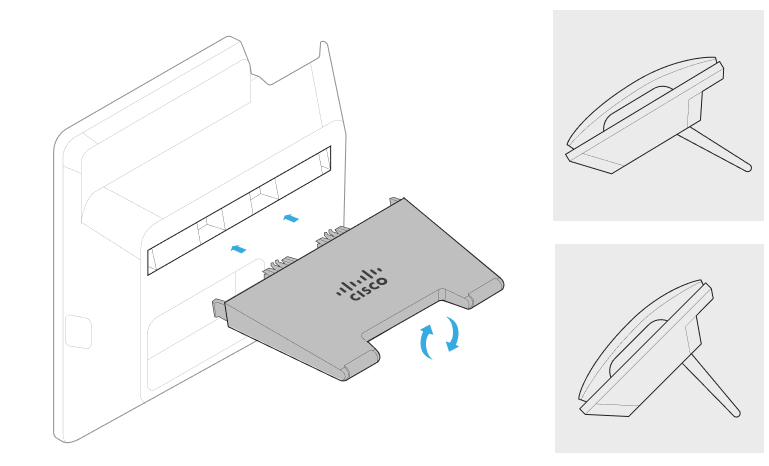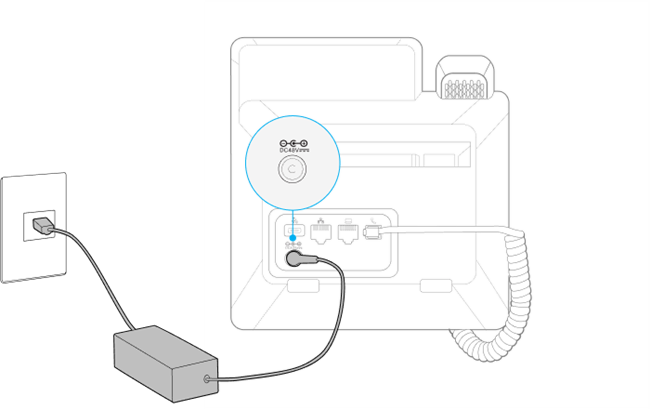- Home
- /
- Article

Get started with Cisco Desk Phone 9800 Series
 In this article
In this article Feedback?
Feedback?Read through the following information before using your phone. This page includes information about the phone hardware and buttons, steps for phone connection and register, help documentation, and technical support.

Cisco Desk Phone 9800 Series is designed to facilitate a convenient and flexible collaboration experience during calls and meetings for diverse roles, work modes, and workplaces.
The available hardware features vary flexibly across models to meet different work settings. See the following table for the supported features on each model.
| Features | Cisco Desk Phone 9841 | Cisco Desk Phone 9851 | Cisco Desk Phone 9861 | Cisco Desk Phone 9871 |
|---|---|---|---|---|
|
Screen | 3.5" Grayscale screen | 3.7" Color screen | 5" Color screen | 5" Touch color screen |
|
Physical line keys |
4 line keys |
6 line keys |
10 line keys |
No physical line keys Supports 32 lines on the touchscreen |
|
Bluetooth® | No | No |
9861: Yes 9861NR: No |
9871: Yes 9871NR: No |
|
Wi-Fi |
No |
No |
9861: Yes 9861NR: No |
9871: Yes 9871NR: No |
|
USB ports |
USB-A port x 1 |
USB-A port x 1 USB-C port x 1 |
USB-A port x 1 USB-C port x 1 |
USB-A port x 1 USB-C port x 1 |
|
KEM support |
Not supported | Supports 1 KEM | Supports 3 KEMs | Supports 3 KEMs |
|
PoE support | PoE Class 2 | PoE Class 3 | PoE Class 3 | PoE Class 3 |
For details about your phone specifications and features, see Cisco Desk Phone 9800 Series Data Sheet.
What's in the box
The following items came with your phone. If any items are missing, contact your administrator.
- Handset x 1
- Foot stand x 1
- Handset cable x 1
- Ethernet cable x 1
- Pointer card x 1, containing the links to the product help and compliance information
If your network doesn't support Power over Ethernet (PoE) or you want to use Cisco Desk Phone 9861 and 9871 in a wireless network, order a power adapter from Cisco. For the list of available power adapters, see the Ordering information section in Cisco Desk Phone 9800 Series Data Sheet.
Hardware and buttons
Your phone has several buttons that allow you to access to the phone features.
The features vary with models. See the information for your phone model.
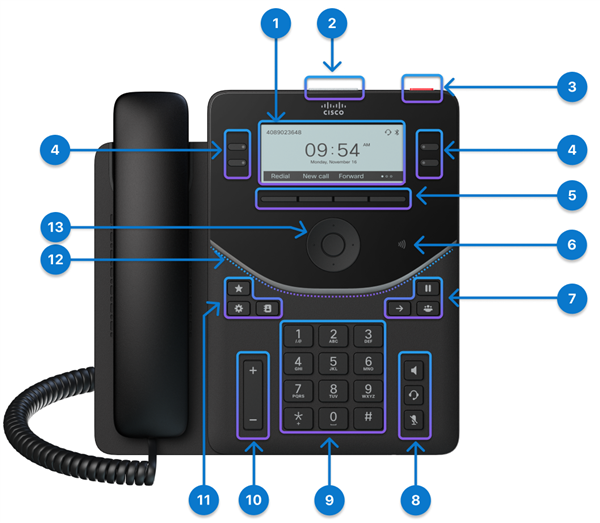
|
Hardware Feature |
Purpose |
|---|---|
|
1. Phone screen |
3.5" grayscale screen (Resolution 384 x 160) |
|
2. Top 360 LED |
Indicates the states of call, message, and the phone. |
|
3. Action button |
Press the button to place a service call, such as an emergency call, if configured. |
|
4. Line buttons and programmable feature buttons |
Access your phone lines, features, and call sessions. |
|
5. Softkey buttons | Access to functions and services. |
|
6. NFC tag |
The location of the NFC tag. Scan the NFC tag to write onboarding information to the phones. The onboarding information can be preconfigured in an industrial NFC writer/reader or a mobile phone running a custom app. |
|
7. Hold/Resume, Transfer, and Conference |
Hold/Resume
Transfer
Conference |
|
8. Headset, Speakerphone, and Mute |
Headset
Speakerphone
Mute |
|
9. Alphanumeric keypad |
Use the keypad to input numbers, letters, and symbols. |
|
10. Volume button |
Adjust the handset, headset, and speakerphone volume (off hook), and the ringer volume (on hook and when the phone is idle). |
|
11. Favorite, Settings, and Contacts |
Favorite
Settings
Contacts |
|
12. Front Arc LED | Indicates the states of the phone, calls,and messages. |
|
13. Navigation Cluster |
The Navigation Cluster consists of the Navigation Ring and Select button. Used to scroll through menus, highlight items and select the highlighted item. |
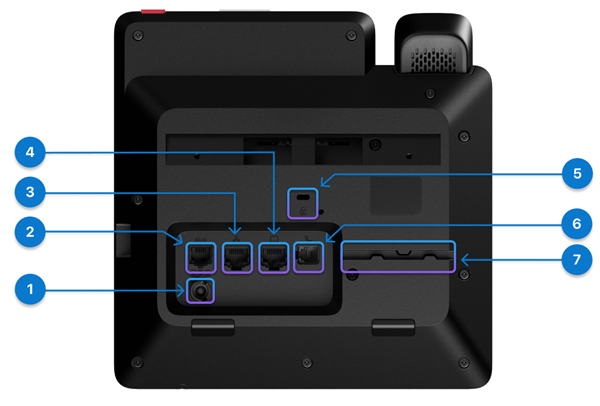
|
Port |
Description |
|---|---|
|
1. Power port |
If your Ethernet doesn't support PoE, connect the power adapter to this port to power up your phone. The power adapter is purchased separately. |
|
2. Auxiliary port |
Used for collecting console logs. |
|
3. Ethernet port |
Connect this port to your Ethernet port on the wall or on your router with the shipped Ethernet cable. |
|
4. PC port |
Optionally, connect your computer to this port to access the network through the phone. |
|
5. Kensington security slot |
To physically secure the phone in public places, attach an anti-theft cable lock to the slot. |
|
6. Handset port |
Connect your handset to this port with the shipped handset cable. |
|
7. Cable socket |
Used for holding the handset cable. |
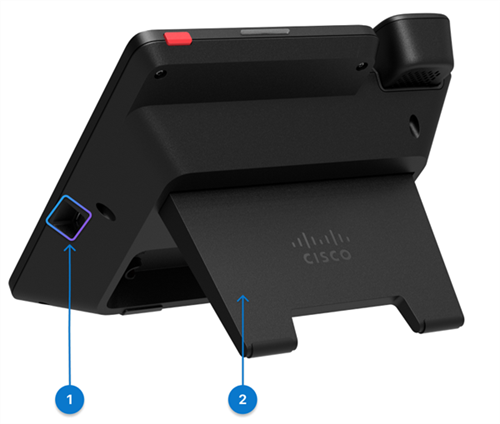
|
Port |
Description |
|---|---|
|
1. USB-A port |
Connect your USB-A headset or Bluetooth® headset dongle to this port. You can also connect a mobile device for charging when the phone is powered from a wall socket. See the USB port specifications and the best practices for device charging in Use Cisco Desk Phone 9800 Series to charge USB-powered devices. |
|
2. Foot stand |
Supports your phone standing on a desk. |
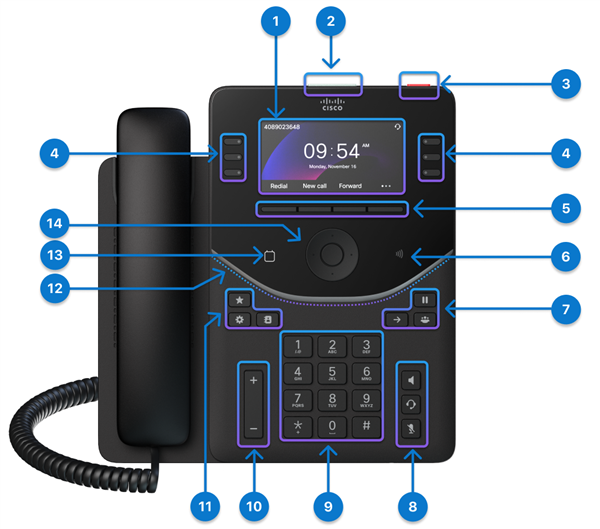
|
Hardware Feature |
Purpose |
|---|---|
|
1. Phone screen |
3.7" color screen (Resolution 480 x 240) |
|
2. Top 360 LED |
Indicates the states of call, message, and the phone. |
|
3. Action button |
Press the button to place a service call, such as an emergency call, if configured. |
|
4. Line buttons and programmable feature buttons |
Access your phone lines, features, and call sessions. |
|
5. Softkey buttons | Access to functions and services. |
|
6. NFC tag |
The location of the NFC tag. Scan the NFC tag to write onboarding information to the phones. The onboarding information can be preconfigured in an industrial NFC writer/reader or a mobile phone running a custom app. |
|
7. Hold/Resume, Transfer, and Conference |
Hold/Resume
Transfer
Conference |
|
8. Headset, Speakerphone, and Mute |
Headset
Speakerphone
Mute |
|
9. Alphanumeric keypad |
Use the keypad to input numbers, letters, and symbols. |
|
10. Volume button |
Adjust the handset, headset, and speakerphone volume (off hook), and the ringer volume (on hook and when the phone is idle). |
|
11. Favorite, Settings, and Contacts |
Favorite
Settings
Contacts |
|
12. Front Arc LED | Indicates the states of the phone, calls,and messages. |
|
13. Calendar button |
Tap the Calendar button to open your calendar. This button is only accessible if your administrator has set up the Calendar service on your phone. |
|
14. Navigation Cluster |
The Navigation Cluster consists of the Navigation Ring and Select button. Used to scroll through menus, highlight items and select the highlighted item. |

|
Port |
Description |
|---|---|
|
1. Power port |
If your Ethernet doesn't support PoE, connect the power adapter to this port to power up your phone. The power adapter is purchased separately. |
|
2. USB-C port |
Connect your USB-C headset. You can also connect a mobile device for charging. See the USB port specifications and the best practices for device charging in Use Cisco Desk Phone 9800 Series to charge USB-powered devices. |
|
3. Ethernet port |
Connect this port to your Ethernet port on the wall or on your router with the shipped Ethernet cable. |
|
4. PC port |
Optionally, connect your computer to this port to access the network through the phone. |
|
5. Kensington security slot |
To physically secure the phone in public places, attach an anti-theft cable lock to the slot. |
|
6. Handset port |
Connect your handset to this port with the shipped handset cable. |
|
7. Cable socket |
Used for holding the handset cable. |
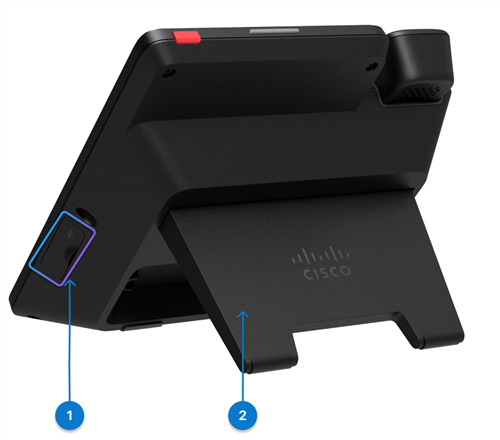
|
Port |
Description |
|---|---|
|
1. USB-A port |
See the USB port specifications and the best practices for device charging in Use Cisco Desk Phone 9800 Series to charge USB-powered devices. |
|
2. Foot stand |
Supports your phone standing on a desk. |
Cisco Desk Phone 9861 is available in two versions: the 9861 model that features Wi-Fi, Bluetooth®, and NFC capabilities, and the 9861NR model that doesn't support Wi-Fi, Bluetooth®, and NFC. Despite this distinction, both versions have the same hardware features.

|
Hardware Feature |
Purpose |
|---|---|
|
1. Phone screen |
5" color screen (Resolution 800 x 480) |
|
2. Top 360 LED |
Indicates the states of call, message, and the phone. |
|
3. Action button |
Press the button to place a service call, such as an emergency call, if configured. |
|
4. Line buttons and programmable feature buttons |
Access your phone lines, features, and call sessions. |
|
5. Softkey buttons | Access to functions and services. |
|
6. NFC tag |
The location of the NFC tag. Scan the NFC tag to write onboarding information to the phones. The onboarding information can be preconfigured in an industrial NFC writer/reader or a mobile phone running a custom app. |
|
7. Hold/Resume, Transfer, and Conference |
Hold/Resume
Transfer
Conference |
|
8. Headset, Speakerphone, and Mute |
Headset
Speakerphone
Mute |
|
9. Alphanumeric keypad |
Use the keypad to input numbers, letters, and symbols. |
|
10. Volume button |
Adjust the handset, headset, and speakerphone volume (off hook), and the ringer volume (on hook and when the phone is idle). |
|
11. Favorite, Settings, and Contacts |
Favorite
Settings
Contacts |
|
12. Front Arc LED |
Indicates the states of the phone, calls, and messages. |
|
12. Calendar button |
Tap the Calendar button to open your calendar. This button is only accessible if your administrator has set up the Calendar service on your phone. |
|
13. Navigation Cluster |
The Navigation Cluster consists of the Navigation Ring and Select button. Used to scroll through menus, highlight items and select the highlighted item. |

|
Port |
Description |
|---|---|
|
1. Power port |
If your Ethernet doesn't support PoE or you're using a wireless network, connect the power adapter to this port to power up your phone. The power adapter is purchased separately. |
|
2. USB-C port |
See the USB port specifications and the best practices for device charging in Use Cisco Desk Phone 9800 Series to charge USB-powered devices. |
|
3. Ethernet port |
Connect this port to your Ethernet port on the wall or on your router with the shipped Ethernet cable. |
|
4. PC port |
Optionally, connect your computer to this port to access the network through the phone. |
|
5. Kensington security slot |
To physically secure the phone in public places, attach an anti-theft cable lock to the slot. |
|
6. Handset port |
Connect your handset to this port with the shipped handset cable. |
|
7. Cable socket |
Used for holding the handset cable. |

|
Port |
Description |
|---|---|
|
1. USB-A port |
See the USB port specifications and the best practices for device charging in Use Cisco Desk Phone 9800 Series to charge USB-powered devices. |
|
2. Foot stand |
Supports your phone standing on a desk. |
Cisco Desk Phone 9871 is available in two versions: the 9871 model that features Wi-Fi, Bluetooth®, and NFC capabilities, and the 9871NR model that doesn't support Wi-Fi, Bluetooth®, and NFC. Despite this distinction, both versions have the same hardware features.

|
Hardware Feature |
Purpose |
|---|---|
|
1. Phone screen |
5" color touch screen (Resolution 1280 x 720) |
|
2. Top 360 LED |
Indicates the states of call, message, and the phone. |
|
3. Action button |
Press the button to place a service call, such as an emergency call, if configured. |
|
4. NFC tag |
The location of the NFC tag. Scan the NFC tag to write onboarding information to the phones. The onboarding information can be preconfigured in an industrial NFC writer/reader or a mobile phone running a custom app. |
|
5. Hold/Resume, Transfer, and Conference |
Hold/Resume
Transfer
Conference |
|
6. Headset, Speakerphone, and Mute |
Headset
Speakerphone
Mute |
|
7. Alphanumeric keypad |
Use the keypad to input numbers, letters, and symbols. |
|
8. Volume button |
Adjust the handset, headset, and speakerphone volume (off hook), and the ringer volume (on hook and when the phone is idle). |
|
9. Favorite, Settings, and Contacts |
Favorite
Settings
Contacts |
|
10. Front Arc LED | Indicates the states of the phone, calls,and messages. |
|
11. Home button |
Press it to go back to the Home screen. |

|
Port |
Description |
|---|---|
|
1. Power port |
If your Ethernet doesn't support PoE or you're using a wireless network, connect the power adapter to this port to power up your phone. The power adapter is purchased separately. |
|
2. USB-C port |
See the USB port specifications and the best practices for device charging in Use Cisco Desk Phone 9800 Series to charge USB-powered devices. |
|
3. Ethernet port |
Connect this port to your Ethernet port on the wall or on your router with the shipped Ethernet cable. |
|
4. PC port |
Optionally, connect your computer to this port to access the network through the phone. |
|
5. Kensington security slot |
To physically secure the phone in public places, attach an anti-theft cable lock to the slot. |
|
6. Handset port |
Connect your handset to this port with the shipped handset cable. |
|
7. Cable socket |
Used for holding the handset cable. |

|
Port |
Description |
|---|---|
|
1. USB-A port |
See the USB port specifications and the best practices for device charging in Use Cisco Desk Phone 9800 Series to charge USB-powered devices. |
|
2. Foot stand |
Supports your phone standing on a desk. |
Connect your phone
Get your phone ready by installing the components and get it connected to the network and power.
The phone register process varies with deployment ways. Your phone may get registered automatically when you connect it to the network. Otherwise, you must get the activation code from your administrator to register your phone.
Use the information in this section to connect your phone in a wired network.
Your phone supports Power over Ethernet (PoE). If your network supports PoE, an Ethernet connection powers up your phone and connects it to the network. You don't have to connect the shipped power adapter.
| 1 |
Connect the shipped handset to the handset port.
|
| 2 |
Insert the foot stand to the slots on the back of the phone. The foot stand is designed for two tilt angles. Try both tilt angles to find the best position for your viewing preferences. To switch to the other angle, unplug the foot stand, flip it over, and reinsert it to the slots.
|
| 3 |
Connect your phone to the network with the shipped Ethernet cable. If your network supports PoE, your phone powers up when you connect it to the network. Otherwise, go to the next step to connect the power adapter.
|
| 4 |
(Optional) Connect your phone to a power socket with the power adapter that you purchased separately from Cisco. Your phone boots up automatically when it connects to the power source.
If your network supports PoE, skip this step.
|
What to do next
Follow the steps in this section to connect your phone in a wireless network.
| 1 |
Connect the shipped handset to the handset port.
|
| 2 |
Insert the foot stand to the slots on the back of the phone. The foot stand is designed for two tilt angles. Try both tilt angles to find the best position for your viewing preferences. To switch to the other angle, unplug the foot stand, flip it over, and reinsert it to the slots.
|
| 3 |
Connect your phone to a power socket with the shipped power adapter.
Your phone boots up automatically when it connects to the power source.
|
| 4 |
Press Start on the Welcome screen. |
| 5 |
Choose your wireless network from the list, enter the username and password, and press Apply. |
What to do next
Register your phone
Depending on how your administrator configures your phone on the call control system, you might use one of the following methods to register your phone:
- Method 1: No action is required during the phone registration. The registration is done automatically.
- Method 2: A 16-digit activation code is required during the phone registration. You can get it from your administrator in advance. Enter the activation code when you are prompted for it.
- Method 3: A service domain and user credentials (user ID and password) are required if you select domain during the phone registration. You can get it from your administrator in advance. Enter the service domain and then user credentials when you are prompted for it.
- Method 4: An alternate TFTP server address is required if your phone is missing a TFTP address. You can get it from your administrator when this situation occurs. You need to manually enter the alternate TFTP server to continue the registration.
- Method 5: For Cisco Desk Phone 9800 Series, you can scan the NFC tag on the phone for the registration. The NFC reader/writer can be preconfigured with necessary information to deploy or provision the phone.
- During registration, the phone checks the DHCP options in the default sequence of 66, 160, 159, and 150 to obtain the URL of the provisioning server. The first valid configuration response it receives (which includes a 401 authorization request), will determine its provisioning server. Ensure that your server is properly configured to process phone registrations successfully.
-
By default, 802.1X authentication is disabled on your phone.
If your network uses the 802.1X protocol, ensure that you enable 802.1X authentication on your phone by accessing . Otherwise, your phone will fail to connect to the network.
- If your phone has HTTP connection issues during the registration, you might be prompted to set up an HTTP proxy server on the phone. The HTTP proxy setting is only required for the phones registered to Webex Calling or BroadWorks. For more information about how to set up the HTTP proxy, see HTTP proxy settings.
Your phone gets registered automatically when it boots up and connects to the network. In this scenario of auto registration, you don't need to enter any input as the whole registration proceeds automatically.
Before you begin
- You have turned on your phone.
- Your administrator has configured your phone on the call control system.
| 1 |
Select Start on the Welcome screen. If you don't take any action, the phone goes to the next step at timeout. Your phone tries to connect to the network. If you use the wireless network, perform the next step. Otherwise, skip it. |
| 2 |
(Optional) Choose your wireless network from the list, enter your credentials, and select Apply. Cisco Desk Phone 9841 and 9851 don't support Wi-Fi. |
| 3 |
Select Next when the screen displays that your phone successfully connects to Ethernet or WiFi. If you don't take any action, the phone goes to the next step at timeout. Then the phone starts checking the configuration, and then starts the registration automatically. If you are prompted to choose a call service, do one of the following actions:
Contact your administrator if you don't know which service to select. Typically, the registration takes about 3 minutes depending on the network condition. After the registration succeeds, your primary line name or number displays on the top left of the phone screen. |
| 4 |
When the registration is complete, you will be prompted to enable or disable the noise removal feature. If you don't take any action, the phone enables the feature at timeout.
This feature can filter out background noises during a call. If you choose to disable the feature now, you can still enable it later.
|
After your phone boots up, it checks the configuration automatically, and you will be prompted to enter an activation code. If you don't have a new activation code, contact your administrator.
Activation codes are used to set up your new phone. They can only be used once, and expire after 1 week.
Before you begin
-
You have turned on your phone.
-
Your phone connects to a wired or wireless network.
-
Get a 16-digit activation code from your administrator.
| 1 |
Select Start on the Welcome screen. If you don't take any action, the phone goes to the next step at timeout. Your phone tries to connect to the network. If you use the wireless network, perform the next step. Otherwise, skip it. |
| 2 |
(Optional) Choose your wireless network from the list, enter your credentials, and select Apply. Cisco Desk Phone 9841 and 9851 don't support Wi-Fi. |
| 3 |
Select Next on the phone screen showing that your phone successfully connects to the network. If you don't take any action, the phone goes to the next step at timeout. Then the phone starts checking the configuration, and then starts the registration automatically. If you are prompted to choose a call service, do one of the following actions according to your network environment and the platform where the phone will be registered:
Contact your administrator if you don't know which service to select. |
| 4 |
When prompted for an activation code, enter your activation code, and select Activate. Your phone starts the registration immediately. Typically, it takes about 3 minutes depending on the network condition. After the registration succeeds, your primary line name or number displays on the top left of the phone screen. |
| 5 |
When the registration is complete, you will be prompted to enable or disable the noise removal feature. If you don't take any action, the phone enables the feature at timeout.
This feature can filter out background noises during a call. If you choose to disable the feature now, you can still enable it later.
|
After your phone boots up, it checks the configuration automatically. If you're prompted to enter an activation code, but you want to use the domain credentials for this registration, select Domain. If you don't have a valid service domain and user credentials, contact your administrator.
- You might be prompted to choose a call service during the registration, depending on your network condition and your administrator's configurations on the call control system.
- This registration method is only available for the phones registered to Cisco Unified CM.
Before you begin
- You have turned on your phone.
- Your phone connects to a wired or wireless network.
- Get a service domain, user ID, and password from your administrator.
| 1 |
Select Start on the Welcome screen. If you don't take any action, the phone goes to the next step at timeout. Your phone tries to connect to the network. If you use the wireless network, perform the next step. Otherwise, skip it. |
| 2 |
(Optional) Choose your wireless network from the list, enter your credentials, and select Apply.
Cisco Desk Phone 9841 and 9851 don't support Wi-Fi. |
| 3 |
Select Next on the phone screen showing that your phone successfully connects to the network. |
| 4 |
When prompted to choose a call service, select . |
| 5 |
When prompted for an activation code, select Domain to switch to the domain activation screen. |
| 6 |
Enter a valid service domain, and select Continue. |
| 7 |
Enter your user ID and password, and press Sign in (on 9841/9851/9861) or tap Apply (on 9871/8875). Your phone starts the registration immediately. Typically, it takes about 3 minutes depending on the network condition. After the registration succeeds, your primary line name or number displays on the top left of the phone screen. |
| 8 |
When the registration is complete, you will be prompted to enable or disable the noise removal feature. If you don't take any action, the phone enables the feature at timeout. This feature can filter out background noises during a call. If you choose to disable the feature now, you can still enable it later. |
In some situation, the Cisco DHCP server doesn't contain the network information of the TFTP servers. To accomplish the registration, you need to manually enter an alternate TFTP server address that your administrator provides.
Before you begin
-
You have turned on your phone.
-
Your phone connects to a wired or wireless network.
-
Get a TFTP server address from your administrator.
-
Get a 16-digit activation code from your administrator, if needed.
| 1 |
Select Start on the Welcome screen. If you don't take any action, the phone goes to the next step at timeout. Your phone tries to connect to the network. If you use the wireless network, perform the next step. Otherwise, skip it. |
| 2 |
(Optional) Choose your wireless network from the list, enter your credentials, and select Apply. Cisco Desk Phone 9841 and 9851 don't support Wi-Fi. |
| 3 |
Select Network. The screen shows the message depending on how your phone connects to the network.
|
| 4 |
Select Network settings on the Network connection screen. |
| 5 |
Toggle on Alternate TFTP in the IPv4 section. |
| 6 |
Enter an IP address in TFTP Server <n>, where <n> represents the type of the TFTP server.
TFTP Server 1 is the primary server, TFTP Server 2 is the secondary server.
|
| 7 |
Select Apply. The registration starts automatically. If your phone requires an activation code to continue, do the following:
Typically, the registration takes about 3 minutes depending on the network condition. After the registration succeeds, your primary line name or number displays on the top left of the phone screen. |
| 8 |
When the registration is complete, you will be prompted to enable or disable the noise removal feature. If you don't take any action, the phone enables the feature at timeout.
This feature can filter out background noises during a call. If you choose to disable the feature now, you can still enable it later.
|
You can scan the phone's NFC tag using an NFC device to provision the onboarding information in advance.
When the phone boots up and connects to a network, it will start the initial registration (Out-Of-Box) automatically.
This topic provides a general procedure about onboarding a phone by using NFC. The actual onboarding procedures might vary depending on the NFC onboarding method that is preconfigured in the NFC data and the call control system where the phone will be registered.
For more information about the NFC onboarding methods and how to prepare the NFC data, see Prepare NFC onboarding data for Desk Phone 9800 Series.
| 1 |
Scan the phone's NFC tag. |
| 2 |
If the phone is offline, turn on the phone and connect it to a network. The onboarding process starts automatically.
During the onboarding process, if certain procedure fails you will be prompted to enter an activation code or choose a call service, or both. |
| 3 |
If prompted, enter an activation code. |
| 4 |
If prompted, choose the call service "Cisco UCM" or "Cisco cloud service".
|
| 5 |
Wait for the registration to complete. |
Need more help?
See the following sections for more help information:
-
To look for more documentation about your phone, go to Help Center.
-
To look for technical support, go to Cisco technical support.
-
For information about how to use and configure KEM, see Cisco Desk Phone 9800 Key Expansion Module.
-
To view the hardware warranty terms, go to Cisco one-year limited hardware warranty terms.
Help Center
Go to the Cisco Desk Phone 9800 Series Help home page to get more help content about your phone. If you don't find the topic of your interest there, try to search for it and use the filters on the left to narrow down the results, if necessary.
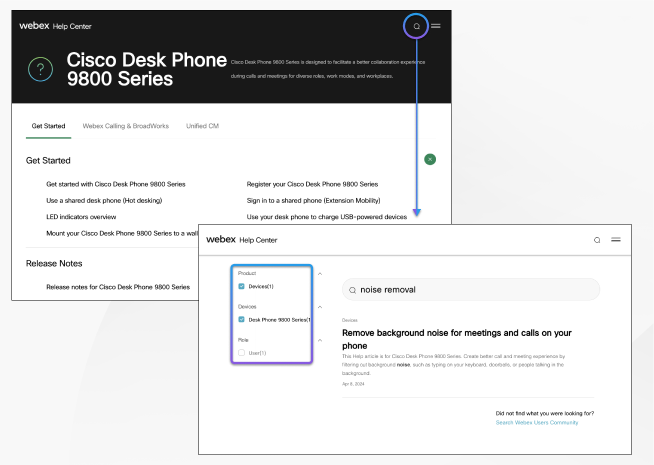
Technical support
Cisco provides around-the-clock technical support services, both online and over the phone to all customers, partners, resellers, and distributors who hold valid Cisco service contracts.
You should have your Cisco.com User ID, Contract, and Serial numbers ready when you contact Cisco Support to prevent any delays with your support request.
In addition, support staff need the following information:
-
Serial number—Every device has a serial number on the back.
-
Time and date issue occurred—Support staff use device logs or cloud metrics to troubleshoot issues. It is helpful to have the approximate local time and date.
-
Device Logs—Support staff may require the device logs to identify the root cause of your issue.
-
A brief description—Include any actions prior to the incident.
Most firmware issues can be resolved by support staff without a Return Material Authorization (RMA). It is best to use the RMA process for hardware issues.
You can find a list of Cisco worldwide support centers at https://www.cisco.com/c/en/us/support/web/tsd-cisco-worldwide-contacts.html.
Cisco one-year limited hardware warranty terms
Special terms apply to your hardware warranty and services that you can use during the warranty period.
Your formal Warranty Statement, including the warranties and license agreements applicable to Cisco software, is available at Product Warranties.

